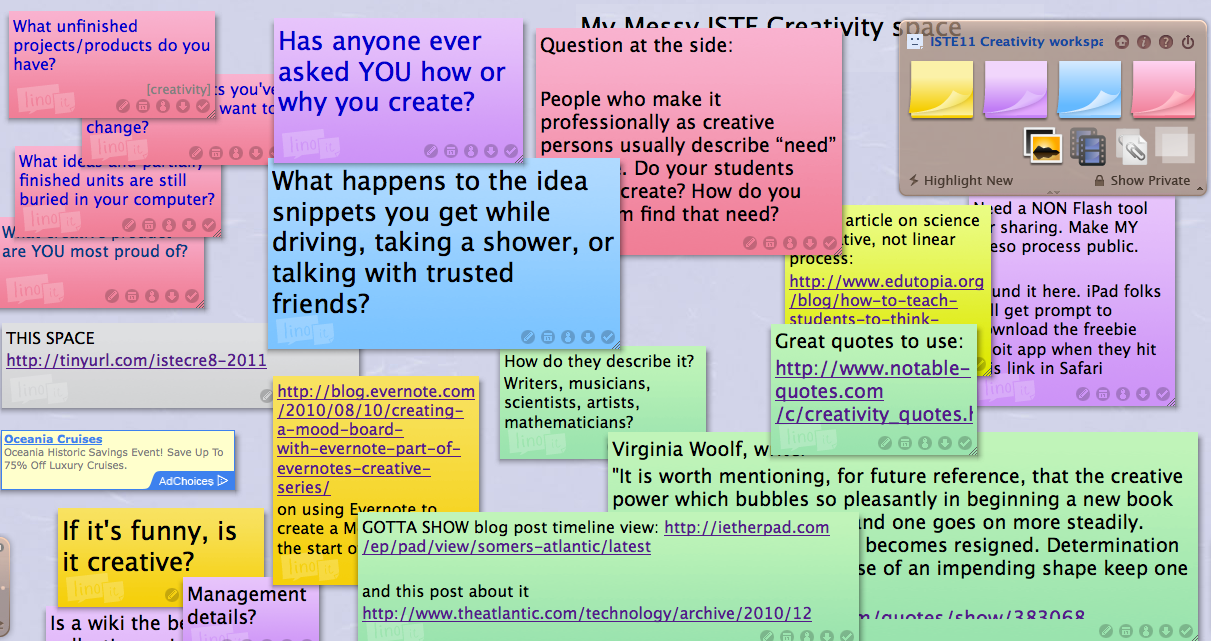Diversions to learning
I met a great group of motivated, creative teachers in our OK2Ask ™ Guided Wiki Walk sessions this week. (OK2Ask ™ is a series of free, online professional development “snack sessions” for teachers offered by TeachersFirst. We use an online classroom space from Blackboard/Collaborate, formerly Elluminate.) The teachers were creating their first wikis or improving on ones they had recently begun. This two meeting offering included time between for the teachers to work on their wikis, then return in 48 hours to learn more, share, and ask a million questions.
One group was so quick to learn and so gregarious, they quickly had their own backchannel running in the chat space, helping answer each other’s questions during demonstrations. They even asked if they could critique each others’ work on the second day. So we diverted widely from our original plans and let them go. Their enthusiasm was EXCITING. Their critique was insightful and discriminating. They talked about pedagogy and practicality. They fed each other ideas. They did everything we want our students to do. These teachers who had never met– a probably never will — scored an #eduwin. Their students are getting the best of the best.
One of the conversations I especially enjoyed was about using templates in wikispaces to differentiate for different learners. You can create a “template” wiki page, such as the skeleton for a student project, but you could also create several templates or options for different levels of project challenge. Students click to create a new page, select the template and — ta-da — their wiki project is started. Right away, the chat buzzed about how to do this without appearing to single out one student over another. Should we perhaps offer all the various templates as options? Or perhaps name them with evens/odds that do not show a clear “level,” so it is easy to simply say, “Sam why don’t you try one of the even numbered templates.” We also talked about using a past student project as a sample or use it to create a template. You can click to create a new template “from” any page that already exists in that wiki, then edit the template as you wish. So if past students have generated unprecedented project options, you can add them to the bank of templates, perhaps stripping out the finished work to reveal the skeleton of a new project format.
As a teacher, I always fear offering a “sample”project. The teacher-pleasers make theirs identical. The perfectionists think they can ONLY do theirs the same way. The minimalists will never go further, and even creative kids often squelch the urge to do something different to conform to the model of school success. The helicopter parents compare their child’s work against the example and tweak it, thinking no one is looking.
Just as our OK2Ask™ session diverted from its original template thanks to participant input, I love the flexibility of any tool that allows projects and products to become springboards to unexpected, broader options. Thanks wikispaces and thanks to the teachers who continue to make OK2Ask™ a load of collaborative fun. #eduwin.


 a time on big issues in education and edtech, and just plain think out loud. I have been fortunate to be at all EBC since its inception in Atlanta a few years ago, and I would never miss this chance to renew my faith in grassroots educators as MiracleGro to a thinking society and to positive change. This group avoids the weeds of griping and generates blooming images of “before and after” learning than any educationinfomercial.
a time on big issues in education and edtech, and just plain think out loud. I have been fortunate to be at all EBC since its inception in Atlanta a few years ago, and I would never miss this chance to renew my faith in grassroots educators as MiracleGro to a thinking society and to positive change. This group avoids the weeds of griping and generates blooming images of “before and after” learning than any educationinfomercial.






